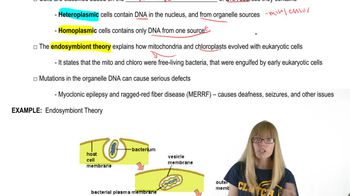Table of contents
- 1. Introduction to Genetics51m
- 2. Mendel's Laws of Inheritance3h 37m
- 3. Extensions to Mendelian Inheritance2h 41m
- 4. Genetic Mapping and Linkage2h 28m
- 5. Genetics of Bacteria and Viruses1h 21m
- 6. Chromosomal Variation1h 48m
- 7. DNA and Chromosome Structure56m
- 8. DNA Replication1h 10m
- 9. Mitosis and Meiosis1h 34m
- 10. Transcription1h 0m
- 11. Translation58m
- 12. Gene Regulation in Prokaryotes1h 19m
- 13. Gene Regulation in Eukaryotes44m
- 14. Genetic Control of Development44m
- 15. Genomes and Genomics1h 50m
- 16. Transposable Elements47m
- 17. Mutation, Repair, and Recombination1h 6m
- 18. Molecular Genetic Tools19m
- 19. Cancer Genetics29m
- 20. Quantitative Genetics1h 26m
- 21. Population Genetics50m
- 22. Evolutionary Genetics29m
3. Extensions to Mendelian Inheritance
Organelle DNA
Problem 21a
Textbook Question
Textbook QuestionThe dodo bird (Raphus cucullatus) lived on the Mauritius Islands until the arrival of European sailors, who quickly hunted the large, placid, flightless bird to extinction. Rapid morphological evolution such as often accompanies island isolation had caused the bird's huge size and obscured its physical resemblance to any near relatives. However, sequencing of mitochondrial DNA from dodo bones reveals that they were pigeons, closely related to the Nicobar pigeon from other islands in the Indian Ocean. Why was mitochondrial DNA suited to the study of this extinct species?
 Verified Solution
Verified SolutionThis video solution was recommended by our tutors as helpful for the problem above
Video duration:
3mPlay a video:
291
views
Was this helpful?
Related Videos
Related Practice
Showing 1 of 2 videos


